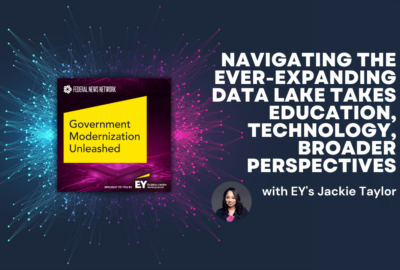Insight by EY
The recipe for making AI a success at your agency
Jeff Bristow, government and public sector technology lead at EY, said agencies should lean into cloud, automation and AI capabilities.
As agencies continue in their information technology modernization journey, top of mind for many leaders is how to create the right foundation to implement artificial intelligence capabilities.
For the most part, agencies will not implement AI in a vacuum. These advanced technologies will be part of new or updated tools. This means agencies need ensure their planning, implementations and data are in the right place to support AI today and in the future.
The General Services Administration’s IT Center of Excellence highlights several areas agencies need to mature to be ready for AI. These includes workforce, data, application development and cloud infrastructure.
Agencies need to understand the key questions to ask, the ingredients to make AI work and how to plan things like data readiness and governance to ensure success.
Jeff Bristow, the government and public sector technology lead at EY, said agencies are facing several big changes that is driving their strategies. First, he said citizen and employee expectations, and outcomes, have evolved.
Second, both groups also want to achieve these outcomes much more quickly and done with, as opposed to, the business or mission organizations.
“The way stakeholders are looking at it and the way we’re looking at it is, what can you do in your journey to the cloud to help add value to demonstrate increased value because the cloud is AI and the ingredients for AI?” Bristow said on the discussion Government Modernization Unleashed: AI Essentials. “It is not the only thing. It is not a silver bullet that’s going to help achieve modernization goals. It can certainly facilitate that, but I think you’re seeing a lot more flexibility now with platforms that can be on our cloud, or your own cloud. I think there’s a lot of optionality that did not exist in the past that’s really helping agencies figure out what’s right for them.”
System consolidation
That optionality agencies are experiencing is letting them focus more on how to achieve their goals today and in the future. Bristow said that same optionality also opens the door for agencies to see their return on investment more quickly.
“At the application level, it’s looking at the ecosystem level. If you look at these agencies, many of them are mature organizations and they may have hundreds of systems. Now, we’re at the point where the business can say, ‘Why do I need hundreds of systems? Is there a way for me to consolidate? Is there a way for me to reduce the swivel chair and going from one terminal to another, one application to another to achieve one outcome?’” Bristow said. “I think one of the big paradigm changes is the people are not just looking at it as an application specific thing. They’re looking at it as a capability. How many applications do I have to support that capability? How many do I need? That’s where you can really start to demonstrate some return on investment and you can really streamline your costs because you’re not maintaining hundreds of applications.”
At the same time, Bristow said, the reduction of applications and the move to the cloud also paves the way to implement more and better automation.
Bristow said agencies have to be focused on moving employees “up the value chain” in terms of the work they do to meet mission goals.
“I think one thing that clients are seeing is that it’s much more challenging to implement artificial intelligence in their agency because it’s an ingredient,” he said. “Artificial intelligence doesn’t exist in a vacuum. There are a lot of considerations that have to be thought through before you can effectively implement it, and really get what you’re looking for out of it. I think a lot of agencies are trying to figure out, based on where they are, what they need to do how can they unlock the power of it?”
Focus on data interoperability
Whether it’s automation or AI or even robotics process automation, the big challenge agencies face is making their data is ready for these capabilities.
“I think what you’ve also seen over the past 17 years as the world has gotten a lot bigger for these ecosystems is a lot of talk about data interoperability. Very rarely does data just sit in one spot, with one agency or one person so there are things happening to your data before it gets to you. There are things that are happening to your data after it gets to you. So understanding that globalization of the data journey is important because you need to understand the state at all times,” he said. “If it’s not consistent and there’s not automation in there to help clean it up and make sure that you’re basically playing a giant game of telephone across all these agencies and it may not look like what you expected it to look like. That’s paramount to really getting the value out of things like artificial intelligence.”
Bristow said the data piece becomes even more important when organizations begin to dip their toes into generative AI.
“The business, the mission and the outcomes are what’s driving all of this activity because if you can get to that outcome, it becomes a much less emotional discussion around how can technology help support that outcome,” he said. “If we can center what we are trying to do with our solutions and not around what AI is telling us to do, or anything else, it’s just the context that we have about the client, the agency and the problems that they’re having. That’s if you can use technology to solve that you’re going to end up having a good solution.”
Listen to the full show:
Copyright © 2025 Federal News Network. All rights reserved. This website is not intended for users located within the European Economic Area.
Jason Miller is executive editor of Federal News Network and directs news coverage on the people, policy and programs of the federal government.
Follow @jmillerWFED






